名词的抽象译法
- 格式:ppt
- 大小:283.50 KB
- 文档页数:11
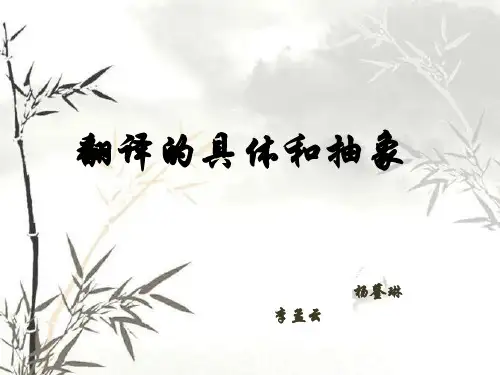

英汉翻译要点归纳一、翻译步骤1.断句:在标点符号、连词、关系词、介词、不定式符号to、分词处断句,找出句子主干On the whole, /(标点符号处)such a conclusion can be drawn /with(介词处) a certain degree of confidence, /but only if the child can be assumed to have had the same attitude /towards the test /as the others /with whom(关系词处) he is being compared, /and(连词处) only if he was not punished/ by lack of relevant information/ which they possessed.2.翻译:根据断句断开翻译并适当调整语序*语序问题:①中文为主语+废话+主要内容英文为主语+主要内容+废话or废话(多为状语)+主语+主要内容中国作为一个发展中的大国高度重视中美两国之间的友谊。
As a major developing country,(状语先译) China attaches great importance to the bilateral relations between China and the U.S(废话后译).②总分关系:中文先分后总,英文先总后分③事实与评论:中文先事实后评论,英文先评论后事实我们要努力学习英语,这是很重要的。
It is very important(先评论) for us to make efforts to study English.●比较级属于评论性词,最后译3.重读:看是否符合中文习惯二、两个规律1.谓语动词过渡:只译主要动词(强势动词,有感情色彩),不译次要动词(弱势动词,无感情色彩)I give you my support.我支持你(give弱势动词,不用翻译)2.抽象名词译法:【抽象名词:the+n.+of结构中名次通常为抽象名词,且常以“-tion,-sion,-ment,-ing”形式出现】译法:A.有动词词根:译为动词The suggestion of mine is that 我建议……B.无动词词根:进行增词the spirit of our nation我们民族所具有的精神C.AB互换(“偏正互换”译法)在英译汉中偏正→正偏treasury of silt宝贵的泥沙 European’s today当今的欧洲人三、中英文两个差异1.长短差异:中文善用短句,用标点隔开;英文善用长句,不用标点→在进行英译汉时要进行断句翻译2.动静差异:中文是动态性语言,善用动词副词,善用强势动词;英文是静态性语言,善用名词,善用弱势动词→在汉译英中常把ad.转化为v.,把v.转化为n.在经济上,我们要加快(副词)建立(动词)社会主义市场经济体制。
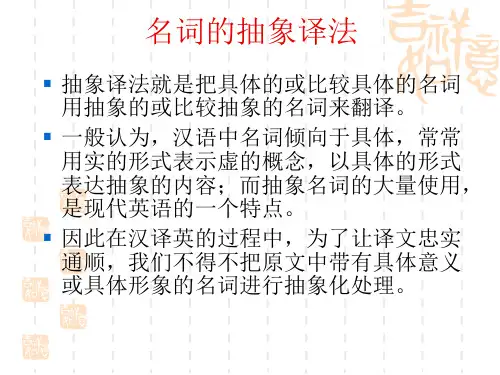
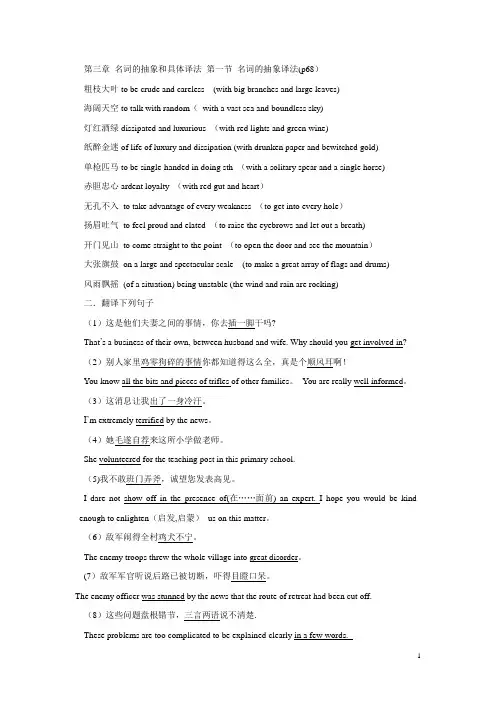
第三章名词的抽象和具体译法第一节名词的抽象译法(p68)粗枝大叶to be crude and careless (with big branches and large leaves)海阔天空to talk with random(with a vast sea and boundless sky)灯红酒绿dissipated and luxurious (with red lights and green wine)纸醉金迷of life of luxury and dissipation (with drunken paper and bewitched gold)单枪匹马to be single-handed in doing sth (with a solitary spear and a single horse)赤胆忠心ardent loyalty (with red gut and heart)无孔不入to take advantage of every weakness (to get into every hole)扬眉吐气to feel proud and elated (to raise the eyebrows and let out a breath)开门见山to come straight to the point (to open the door and see the mountain)大张旗鼓on a large and spectacular scale (to make a great array of flags and drums)风雨飘摇(of a situation) being unstable (the wind and rain are rocking)二.翻译下列句子(1)这是他们夫妻之间的事情,你去插一脚干吗?That’s a business of their own, between husband and wife. Why should you get involved in? (2)别人家里鸡零狗碎的事情你都知道得这么全,真是个顺风耳啊!You know all the bits and pieces of trifles of other families。
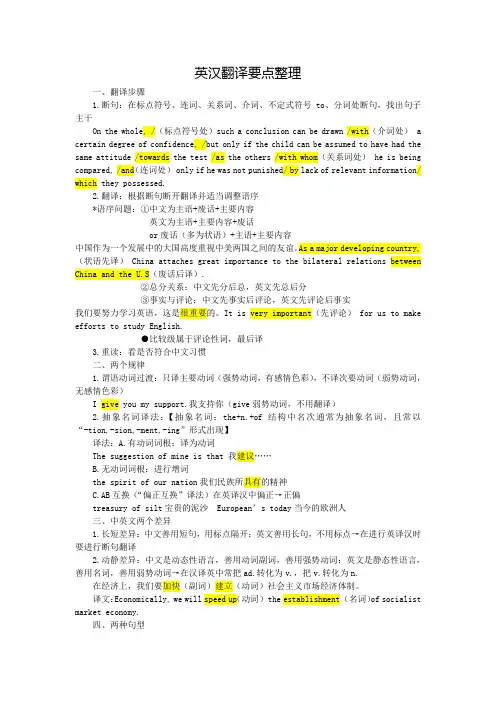
英汉翻译要点整理一、翻译步骤1.断句:在标点符号、连词、关系词、介词、不定式符号to、分词处断句,找出句子主干On the whole, /(标点符号处)such a conclusion can be drawn /with(介词处) a certain degree of confidence, /but only if the child can be assumed to have had the same attitude /towards the test /as the others /with whom(关系词处) he is being compared, /and(连词处) only if he was not punished/ by lack of relevant information/ which they possessed.2.翻译:根据断句断开翻译并适当调整语序*语序问题:①中文为主语+废话+主要内容英文为主语+主要内容+废话or废话(多为状语)+主语+主要内容中国作为一个发展中的大国高度重视中美两国之间的友谊。
As a major developing country,(状语先译) China attaches great importance to the bilateral relations between China and the U.S(废话后译).②总分关系:中文先分后总,英文先总后分③事实与评论:中文先事实后评论,英文先评论后事实我们要努力学习英语,这是很重要的。
It is very important(先评论) for us to make efforts to study English.●比较级属于评论性词,最后译3.重读:看是否符合中文习惯二、两个规律1.谓语动词过渡:只译主要动词(强势动词,有感情色彩),不译次要动词(弱势动词,无感情色彩)I give you my support.我支持你(give弱势动词,不用翻译)2.抽象名词译法:【抽象名词:the+n.+of结构中名次通常为抽象名词,且常以“-tion,-sion,-ment,-ing”形式出现】译法:A.有动词词根:译为动词The suggestion of mine is that 我建议……B.无动词词根:进行增词the spirit of our nation我们民族所具有的精神C.AB互换(“偏正互换”译法)在英译汉中偏正→正偏treasury of silt宝贵的泥沙 European’s today当今的欧洲人三、中英文两个差异1.长短差异:中文善用短句,用标点隔开;英文善用长句,不用标点→在进行英译汉时要进行断句翻译2.动静差异:中文是动态性语言,善用动词副词,善用强势动词;英文是静态性语言,善用名词,善用弱势动词→在汉译英中常把ad.转化为v.,把v.转化为n.在经济上,我们要加快(副词)建立(动词)社会主义市场经济体制。
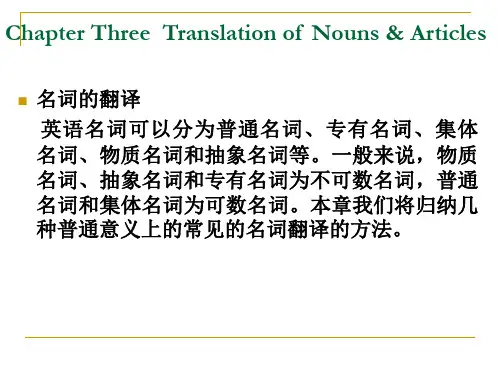
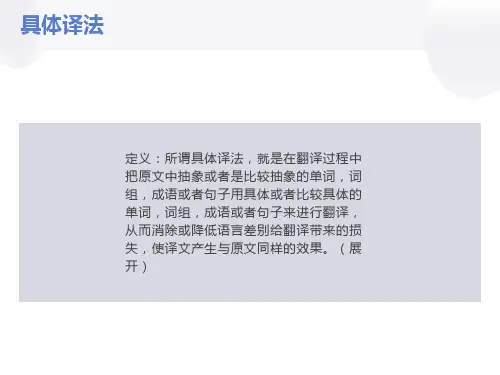
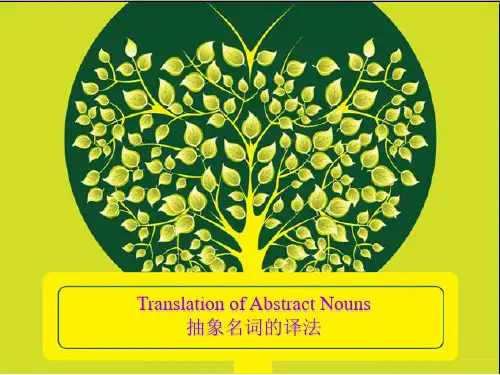
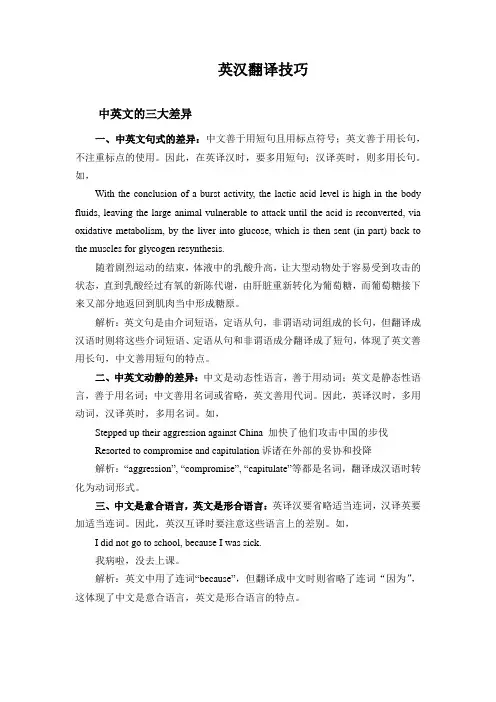
英汉翻译技巧中英文的三大差异一、中英文句式的差异:中文善于用短句且用标点符号;英文善于用长句,不注重标点的使用。
因此,在英译汉时,要多用短句;汉译英时,则多用长句。
如,With the conclusion of a burst activity, the lactic acid level is high in the body fluids, leaving the large animal vulnerable to attack until the acid is reconverted, via oxidative metabolism, by the liver into glucose, which is then sent (in part) back to the muscles for glycogen resynthesis.随着剧烈运动的结束,体液中的乳酸升高,让大型动物处于容易受到攻击的状态,直到乳酸经过有氧的新陈代谢,由肝脏重新转化为葡萄糖,而葡萄糖接下来又部分地返回到肌肉当中形成糖原。
解析:英文句是由介词短语,定语从句,非谓语动词组成的长句,但翻译成汉语时则将这些介词短语、定语从句和非谓语成分翻译成了短句,体现了英文善用长句,中文善用短句的特点。
二、中英文动静的差异:中文是动态性语言,善于用动词;英文是静态性语言,善于用名词;中文善用名词或省略,英文善用代词。
因此,英译汉时,多用动词,汉译英时,多用名词。
如,Stepped up their aggression against China 加快了他们攻击中国的步伐Resorted to compromise and capitulation诉诸在外部的妥协和投降解析:“aggression”, “compromise”, “capitulate”等都是名词,翻译成汉语时转化为动词形式。
三、中文是意合语言,英文是形合语言:英译汉要省略适当连词,汉译英要加适当连词。
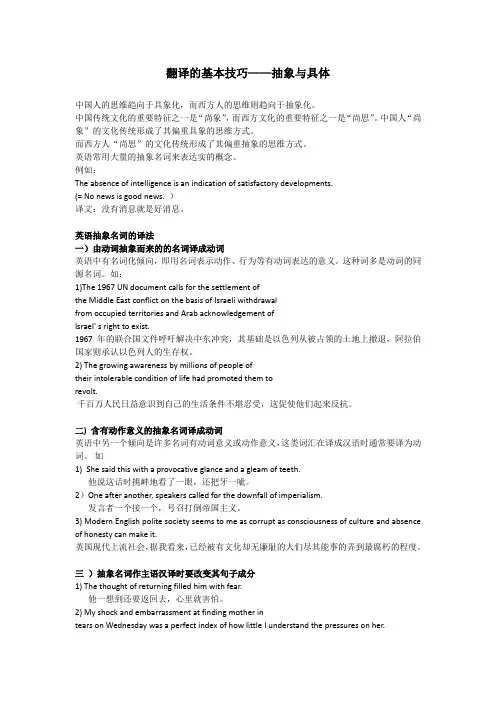
翻译的基本技巧——抽象与具体中国人的思维趋向于具象化,而西方人的思维则趋向于抽象化。
中国传统文化的重要特征之一是“尚象”,而西方文化的重要特征之一是“尚思”。
中国人“尚象”的文化传统形成了其偏重具象的思维方式。
而西方人“尚思”的文化传统形成了其偏重抽象的思维方式。
英语常用大量的抽象名词来表达实的概念。
例如:The absence of intelligence is an indication of satisfactory developments.(= No news is good news. )译文:没有消息就是好消息。
英语抽象名词的译法一)由动词抽象而来的的名词译成动词英语中有名词化倾向,即用名词表示动作、行为等有动词表达的意义。
这种词多是动词的同源名词。
如:1)The 1967 UN document calls for the settlement ofthe Middle East conflict on the basis of Israeli withdrawalfrom occupied territories and Arab acknowledgement ofIsrael' s right to exist.1967年的联合国文件呼吁解决中东冲突,其基础是以色列从被占领的土地上撤退,阿拉伯国家则承认以色列人的生存权。
2) The growing awareness by millions of people oftheir intolerable condition of life had promoted them torevolt.千百万人民日益意识到自己的生活条件不堪忍受,这促使他们起来反抗。
二) 含有动作意义的抽象名词译成动词英语中另一个倾向是许多名词有动词意义或动作意义,这类词汇在译成汉语时通常要译为动词。
如1) She said this with a provocative glance and a gleam of teeth.他说这话时挑衅地看了一眼,还把牙一呲。
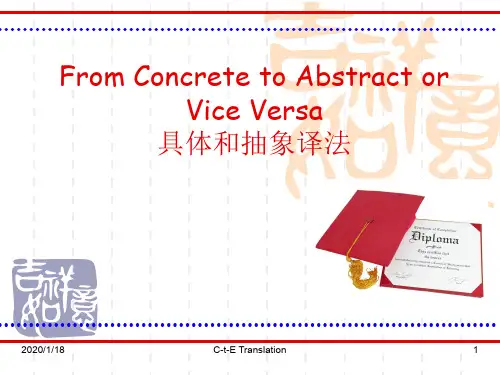
英译中总结1.具体名词+抽象名词:译“具体”不译“抽象”。
通常形式为the+n.+of+n.Eg:①A number of writers have raised questions the desirability of faster economic growth as an end in itself, at least in the wealthier industrialized countries.译:近年来,不少人或撰文或著书,已经提出质疑:为经济而发展经济,至少在较富裕的国家究竟有无必要?②An economy whose capacity to provide all these things is not expanding is said to have succumbed to the disease of stagnation.译:当某个经济体的这种产出能力不再扩大,人们就认为它遭遇了经济停滞。
③But by increasing the risks of their obsolescence it adds also to their anxiety.译:但是由于更新换代的速度太快,反而使人们倍感焦虑。
④One major risk to stability is the growing imbalance in global payments and the associated market anxiety about the possibility of a disorderly adjustment of the imbalance through sudden changes in exchange rates and global interest rates.译:影响稳定的一个主要风险是全球支付体系的不断失衡,市场随之会担心失衡现象有可能带来通过突然改变汇率和全球利率的无序调整。
汉英翻译基础教程第一章汉英词汇比较与翻译 (2)第二章词法翻译的一般技巧 (4)第三章名词的抽象和具体译法 (9)第四章动词的翻译 (11)第五章数词和冠词的翻译 (12)第六章成语的英译 (13)第七章修辞格的翻译 (17)笫八章文化词语的翻译 (19)第九章汉英句子比较与翻译 (20)第十章换序和转态译法 (23)笫十一章断句合句译法 (25)笫十二章长句的翻译 (27)第十四章汉英语篇比较与翻译 (29)第十五章风格与翻译 (30)第十六章语用与翻译 (32)第一章汉英词汇比较与翻译第一节翻译中的选义一、结合语境选择较贴切的译文1. b2. a3. b4. a二、译出下列词语,注意词语的不同搭配1. a swarm of beesa brood of chickensa litter of pups2. a bevy of beautiful ladiesa pack of houndsa team of ducksa herd of antelopes3. unfailing supportproactive fiscal policymake effective use of overseas resources4. make a phone calltake a taxiknit a woolen sweaterfetch waterplay basketballspray insecticide5. basic wagecapital constructionessential commodityprimary industryfundamental interest三、翻译下列句子,注意画线词语的理解1. The two leaders exchanged views on bilateral relations and issues of common concern2. Party members should listen carefully to the opinions of the general public.3. They offered some suggestions for the revision of the plan.4. Everyone complained against such a practice.5. They had a dispute at the meeting.6. You should follow the doctor's advice.7. They reached a consensus on this issue.8. There is still some unfinished business to settle.9. We have consulted him about the matter.10. Please go back. There is nothing of your concern now第二节翻译中的选词一、翻译下列各句,注意词的选择和搭配。